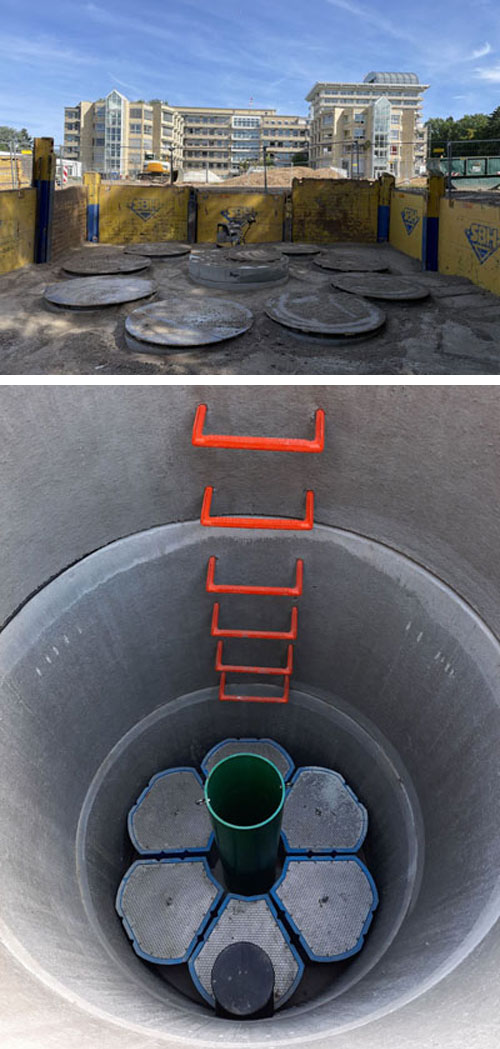REFERENCES
FOR THE PROTECTION OF OUR WATERS

REFERENCE HYDROSYSTEM FRANKFURT
Clean drainage
The drainage network was completely restructured to prevent the sewer from becoming overloaded during heavy rain events on the grounds of the BGU (Berufsgenossenschaftliche Unfallklinik) in Frankfurt am Main. The Finger-Beton-Unternehmensgruppe’s hydrosystem played a central role in this.
Clean drainage with precast concrete elements on hospital campus in Frankfurt BGU Frankfurt a.M.: A central component in the construction of new rainwater/mixed water channels and infiltration systems is a special hydro system for cleaning heavily contaminated surface water. By summer 2026, two new ward blocks with a total of 308 beds will be built on the BGU Frankfurt a.M. hospital campus in the Seckbach district to the east of the BAB 661. As part of this project, the BGU is planning to reorganize the drainage system on large parts of the site. This includes the construction of new rainwater and combined sewers as well as infiltration systems, including a necessary pre-treatment plant, with the aim of purifying the rainwater and returning it to the groundwater. The central components here are a special hydro system for cleaning heavily contaminated surface water and special custom-made reinforced concrete structures. The entire site has around 14,000 m² of roof and traffic areas on which rainwater accumulates. Thomas Nichler from Dahlem-Ingenieuren in Darmstadt explains the measure: “Our task was to completely restructure the drainage network to prevent the sewer from becoming overloaded during heavy rain events. Originally, the site area with a connection to the municipal combined sewer was around 25 hectares. Of this, around 19 hectares were to be redirected to a new infiltration system, leaving only 6 hectares whose precipitation is fed into the combined sewer.”
However, one important requirement had to be met:
Only clean water may be discharged into the approx. 1,000 m3 infiltration system. The solution: The rainwater on the site is fed into an approx. 300 meter long channel made of DN 500 reinforced concrete pipes and flows via a DN 2000 distribution shaft into a filter system for the pre-treatment of contaminated rainwater.
Frank Becker from the Fronhausen plant of the Finger-Beton-Unternehmensgruppe, which supplied the precast concrete parts alongside the other Finger plants involved from Idar-Oberstein, Stockstadt and Kruft, explains how it works: “The filter system here consists of eight DN 1500 concrete treatment plants arranged in a star shape around the distribution shaft, which are already equipped with our hydrosystem at the factory. This arrangement ensures an even load on the filter systems before infiltration. After the water flows in tangentially to the hydrodynamic separator, solids settle to the bottom. Six filter elements are located in the middle of the filter shaft, which filter and absorb the fines using the upflow method. The clean water passes through an oil separator and is then fed into a infiltration system.”
Year of construction: 2021
Type of connected areas: Roof and traffic areas
Area size: approx. 14,000 m²
Filter system: 9 Hydrosystems 1,500 and Hydroshark 1,500
YOU NEED PROFESSIONAL
SUPPORT OR
HAVE QUESTIONS FOR US?

Jonas Bitterling, M. Eng.
Project Engineer
Tel +49 (0) 7334 92460-12
Mail bitterling@3ptechnik.de

Daniel Betschner,
Master Professional of
Technical Management (CCI)
Project Engineer
Tel +49 (0) 7334 92460-32
Mail betschner@3ptechnik.de
